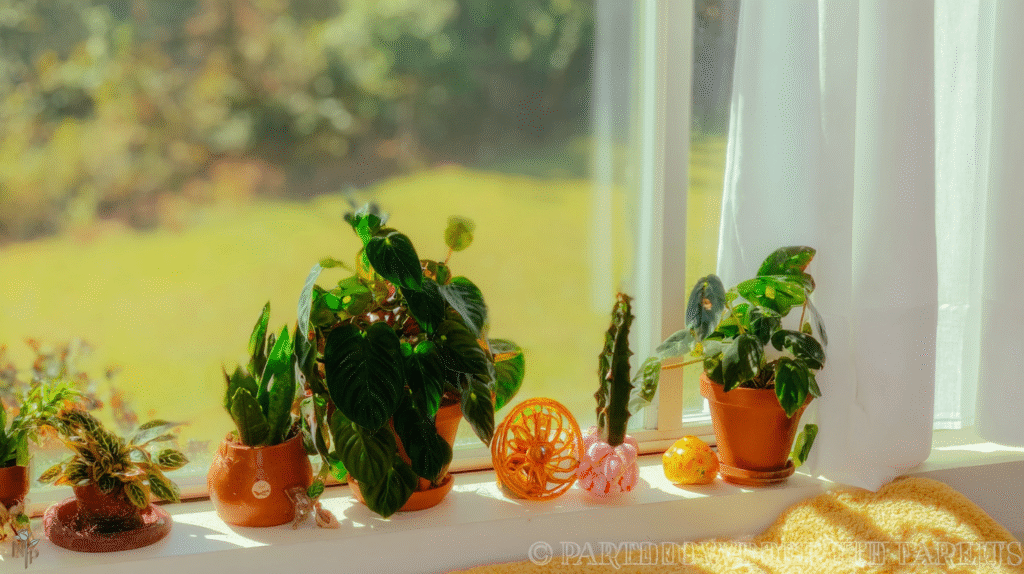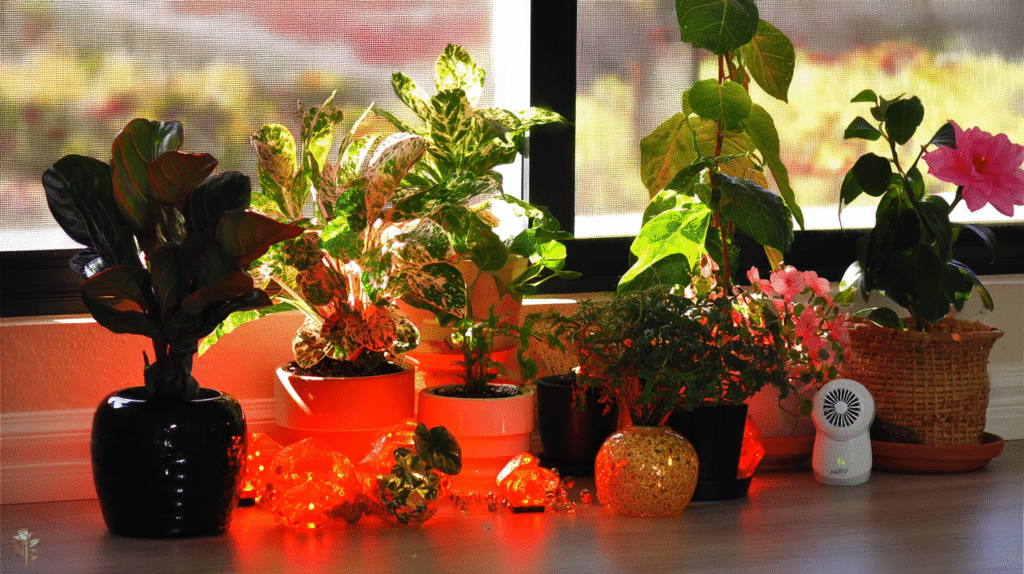Killed my first 20 houseplants thinking “water weekly, bright indirect light” was actual advice. Turns out that’s like saying “drive carefully” to someone who’s never seen a car. My spider plant drowned. My succulent melted. My fiddle leaf fig got sunburned then died of thirst. Twenty plants, twenty different deaths, all from screwing up the two most basic things: water and light.
Now I have 47 plants (yes, I counted), including that original spider plant’s grandson and a fiddle leaf that’s taller than me. The difference? I finally learned that “proper watering” and “proper sunlight” mean completely different things for different plants, and those vague care tags are basically useless.
Here’s what three years and roughly $400 worth of dead plants taught me about actually keeping things alive.

Understanding Watering Fundamentals
The Finger Test Is Only Half Right
Everyone says “stick your finger in the soil.” Cool. How deep? What should it feel like? When I started, “moist” meant different things for different plants and I had no idea.
Here’s what actually works:
- Succulents/cacti: Dry all the way through the pot
- Tropical plants: Top 2 inches dry
- Ferns: Top inch barely dry
- Peace lily: Just watch it droop, then water (seriously, built-in alarm system)
Took me six dead plants to realize my “thorough watering” of succulents was actually murder by drowning.
Water Quality Matters More Than You Think
Spent a year wondering why all my plants had brown tips. Blamed everything – humidity, fertilizer, my negative energy. Turns out my tap water has 400ppm dissolved minerals and plants hate that.
The hierarchy of water quality:
- Rainwater (free, perfect, pain to collect)
- Distilled ($1/gallon, annoying to haul)
- Filtered (Brita works for most plants)
- Tap water left out 24 hours (chlorine evaporates, minerals don’t)
- Straight tap (works for tough plants, kills sensitive ones)
My Calatheas get distilled. My pothos gets straight tap. My bank account cries but my plants live.
The Drainage Situation Nobody Explains
“Good drainage” doesn’t just mean holes in the pot. Learned this after root rot victim number five.
What good drainage actually means:
- Holes in the pot (obviously)
- Fast-draining soil (water shouldn’t pool on top)
- Not letting plants sit in drainage water
- Proper pot size (too big = soil stays wet too long)
My game-changer: lifting pots to check weight. Heavy = wet. Light = dry. More accurate than any finger test.
Decoding Sunlight Requirements
What “Bright Indirect” Actually Means
This phrase killed more of my plants than anything else. “Bright indirect” to me meant “anywhere inside near-ish to a window.” Wrong. So wrong.
Bought a light meter for $15. Life-changing. Here’s what those vague terms actually mean:
- Direct sun: 2000+ foot candles (actual sun rays hitting leaves)
- Bright indirect: 400-800 FC (near window but no direct rays)
- Medium light: 200-400 FC (few feet from window)
- Low light: 50-200 FC (across room from window)
My “bright” north window? 150 FC. My “perfect” spot? 75 FC. No wonder everything died.
Window Direction Myths and Reality
Everyone says “south windows are brightest.” Yeah, if you don’t have buildings, trees, or awnings blocking them.
My actual window situations:
- South window: Blocked by apartment building, gets 2 hours direct sun
- East window: Best spot, 4 hours gentle morning sun
- West window: Nuclear afternoon sun, murders everything
- North window: Cave darkness, only pothos survives
Test your actual light, not what the internet says your windows should provide.
Seasonal Light Changes That Kill Plants
Nobody told me winter sun is completely different. My succulents that thrived all summer started dying in November. Hadn’t moved them. Hadn’t changed care. The sun had.
Winter adjustments that saved my plants:
- Move everything closer to windows (light is 50% weaker)
- Add grow lights for sun-lovers ($30 saved multiple plants)
- Accept that growth slows or stops
- Reduce watering (less light = less water needed)
Plant-Specific Requirements That Actually Work
Succulents and Cacti
Water: Every 2-3 weeks summer, monthly in winter. Soil must be completely dry. Light: Direct sun or they stretch into sad noodles. Mine touch the south window glass. My mistakes: Treating them like houseplants. They’re desert plants held hostage indoors.
Tropical Foliage (Monstera, Pothos, Philodendron)
Water: When top 2 inches dry, usually weekly in summer. Light: Bright indirect, but honestly adaptable. My pothos lives in a bathroom with no windows. What works: These are the golden retrievers of plants – happy with whatever you give them.
Fussy Plants (Calathea, Fiddle Leaf Fig, Maidenhair Fern)
Water: Consistently moist but never soggy (helpful, right?). Check every 2-3 days. Light: Bright indirect but no direct sun ever. One hour of direct sun burned my Calathea. Reality: These want rainforest conditions. Get a humidifier or watch them die slowly.

Common Watering Mistakes I Made
The Overwatering Epidemic
Killed more plants with too much water than any other way. Signs I ignored:
- Yellow leaves (thought it needed more water)
- Soft, mushy stems (thought it was thirsty)
- Fungus gnats everywhere (thought they were fruit flies)
- Soil that never dried out (thought that was good)
Now I err on the side of underwatering. Dry plants recover. Rotted ones don’t.
The Schedule Trap
Watered every Sunday because that was “plant day.” Plants don’t follow human schedules. Summer they might need water twice a week. Winter, every two weeks.
Now I check soil, not calendar. Revolutionary concept.
Wrong Water Temperature
Shocked multiple plants with cold water straight from the tap. Room temperature water only now. I’m not trying to give my plants hypothermia.
Sunlight Mistakes That Cost Me
The Gradual Sun Introduction Failure
Moved my rubber plant from medium light directly to full sun because “it needs more light.” Leaves literally burned black in one afternoon.
Now I move plants gradually over two weeks. Few inches closer to window every few days. No more plant sunburns.
Not Rotating Plants
My monstera grew completely sideways reaching for light. Looked ridiculous. Now everything gets a quarter turn weekly. Even growth, no plant yoga poses.
Believing “Low Light” Means “No Light”
Put a ZZ plant in my windowless bathroom because “they tolerate low light.” It survived but grew exactly zero new leaves in a year. Low light means low, not none. Even “low light” plants need some actual light.
My Current Setup That Works
The Watering Station
All plants accessible for checking, watering can always filled with room-temp water, moisture meter for backup, and calendar notes for what got watered when (because I forget).
The Light Zones
- Window touching: Cacti and succulents
- 1-2 feet from window: Tropical plants
- 3-4 feet away: Low light tolerant plants
- Grow light corner: Winter backup for struggling plants
The Recovery Ward
Struggling plants go under the grow light with careful water monitoring. 50% recovery rate, which beats 0% from my previous “ignore it and hope” method.

The Bottom Line on Water and Light
After killing $400 worth of plants, here’s what actually matters:
Watering: Check the actual soil, not the schedule. When in doubt, wait a day. Underwatered plants recover, overwatered ones rot. Use decent water for sensitive plants, tap for tough ones.
Light: Buy a light meter or use a phone app. “Bright indirect” is meaningless without actual measurements. Seasons change light dramatically. Most plants want more light than you think.
The universal truth: Every plant is different. That care tag is a suggestion, not gospel. Watch your actual plant in your actual space. Drooping? Yellow? Stretching? It’s telling you what it needs.
My 47 plants aren’t perfect. They’ve got brown tips, occasionally droopy leaves, and my fiddle leaf still hates me. But they’re alive, growing, and I haven’t killed anything in six months. That’s the real victory.






